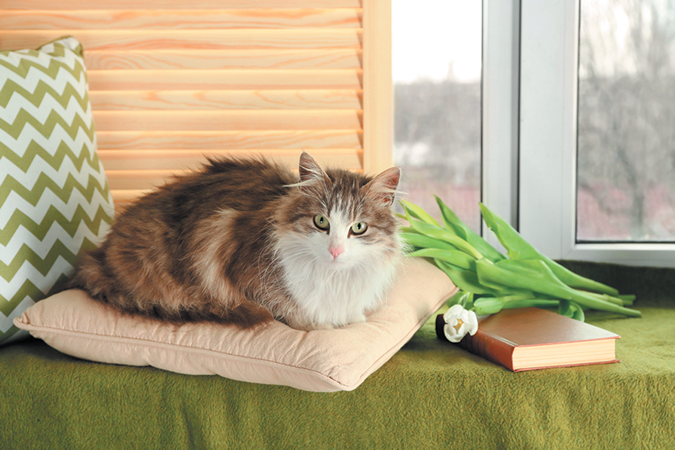Cats are wily about concealing their pain. It comes from a genetically encoded instinct for self-protection, never wanting to let potential predators know they may be vulnerable. But if your cat has arthritis, there are frequently telltale signs.
It’s worth learning them. Research suggests that some 90 percent of cats over the age of 12 have some degree of arthritis, characterized by degenerating joints, and that even 20 percent of younger adult cats show signs of it. And if your pet does have arthritis, it means the soft cartilage in his joints that normally keeps two bones from touching is wearing away — and causing bone-on-bone scraping that can sometimes prove especially painful.
Tip-offs to arthritis pain
Once in a while you will see actual limping, but the signs of arthritis pain in a cat are usually more subtle. Ask yourself the following questions:
Has there been a general decrease in my cat’s activity?
Has my once agile pet become increasingly reluctant to jump to his favorite window seat, or has he stopped jumping on the counter when I’m preparing meals?
Is he spending more time in one location in general?
Is he eating and sleeping more? (Cats, just like people in pain, sometimes try to self-medicate with food and “go away” by sleeping.)
Has he become less fastidious about grooming? (Painful joints may make it harder for him to turn around and get at hard-to-reach spots.)
Is he having accidents outside the litter box (which could indicate difficulty climbing over the edge)?
A number of these signs might seem like the slowdown of aging, but they warrant a doctor’s visit to confirm or rule out arthritis, says Tufts board-certified orthopedic surgeon Michael Kowaleski, DVM, who often treats cats with joint disease. “We can detect decreased range of motion in a limb, and we will surely be able to notice if a cat experiences pain in a joint by palpating [feeling] the limbs during a clinical exam.” Dr. Kowaleski says that veterinarians will also check for reduced muscle mass around joints, a hallmark of the condition. Finally, if the vet suspects arthritis, he will take x-rays. That confirms the presence — or absence — of a problem in the joints.
A four-pronged treatment approach
The earlier arthritis is discovered, Dr. Kowaleski says, the more effective the treatment, which consists of four modalities.
1|Weight loss. Excess weight is second only to advanced age as a cause of arthritis because the additional poundage puts extra pressure on joints that might already be compromised. Losing even a few pounds can frequently work wonders for pain relief.
2|Regular moderate exercise. It might sound counterintuitive to make sure that a cat with compromised joints does some more moving about, but encouraging your pet to chase a beam of light or wrestle with a food puzzle pumps oxygenated blood and nutrients into his joints and also builds up the muscle around them. Stronger muscles can better act as support for the compromised joints.
3|Medical therapy. A cat with arthritis might very well need an analgesic such as an anti-inflammatory drug, which your veterinarian can prescribe in the right dose.
4|Supplementation with cartilage-protecting agents. Medications like glucosamine and chondroitin can improve cartilage health. Again, your vet can recommend the appropriate amount and an appropriate brand with good quality control.
These four steps taken together can do a great deal to reduce arthritis pain, Dr. Koweleski says. If they don’t, your cat can even undergo surgery to reduce pain, for instance, by having a complete hip replacement. There are a lot of weapons in the arthritis-treatment arsenal that can really help a great deal.
Is the Arthritis the Result of Joint Dysplasia?
Many cats are born with congenital joint defects known as joint dysplasia, in which something about the joints is misshapen and causes problems over time. The most frequently diagnosed of these problems in cats is hip dysplasia, meaning the hip’s ball-and-socket configuration is misaligned. Over time, that gradually erodes the protective cartilage in that spot, meaning there’s a loss of cushioning that will eventually prove quite painful. It will lead to bone-on-bone rubbing whenever the cat takes a step. In such a case, a hip replacement surgery may very well be the way to go.




